Your one-stop shop for control valves
What do you look for in a control valve supplier? Someone who has a complete range of linear and rotary models? A company with a proven track record? Experts who can solve critical service issues such as cavitation and noise attenuation? A stockist that can deliver maintenance and service throughout the lifetime of the valve? Or maybe a partner who understands the complexity of your process? If you answer yes to any of these questions, then perhaps you should contact the experts of Valmet Flow Control valve solutions.
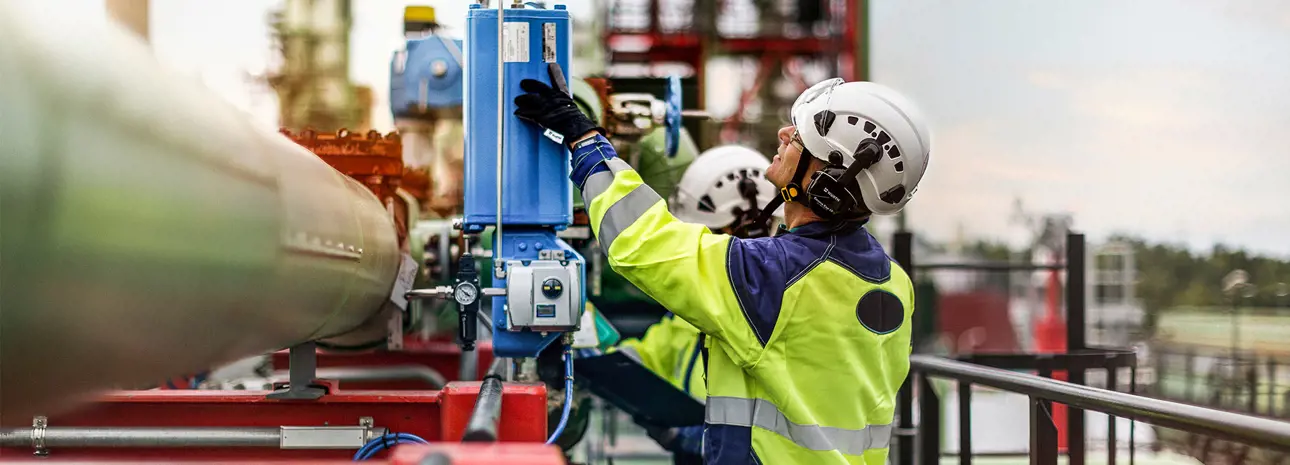
When it comes to control valve requirements no two are ever the same. That’s the clear message Valve World received from Markus Hauhia (Director, Globe Valves, based in Korea) and Ismo Niemelä (on right, Director, Control Valve Product Center, based in Finland) when talking to them for this cover story. This is why they indicate, that Valmet Flow Control experts always take the time to talk extensively to clients before helping them to select the best control valve for their individual application.
“There is such an incredible range of parameters that need to be taken into account,” states Ismo. “Not just the pressure and temperature of the process or the required controllability, but also issues such as the need to prevent cavitation, to control noise, to keep within emission limits, etc. This means selecting a control valve always requires due care and attention.”
It is also important to respect the differing priorities that customers may set, he continues. “For example, end users might want to know more about the valve’s controllability or emissions control performance whilst EPCs who are working to project deadlines might ask first and foremost about delivery times and seek cost-effective solutions. Then again, other clients may be willing to pay more for a valve which can be easily modified once installed. For example, their focus may be to get a new-build plant up and running to start generating revenues so they are quite prepared to spend extra money later on should say the valve trims need changing.”
We have always entered into dialogue with customers this way and indeed is increasingly being relied upon as a source of control valve expertise. “That is especially the case as end users further scale back their own engineering departments,” comments Markus. “We absolutely see it as our role to fill the knowledge gap and will assist customers with quality information they can rely on.
In fact, on larger projects we can have one of our engineers seconded to the customer’s premises. Sitting alongside the local engineering team he is ideally placed to perform the sizing calculations and can help to identify any anomalies to optimize the desired process controllability.”
Valmet Flow Control has a comprehensive range of control valves, actuators and positioners
Asked whether customers couldn’t simply repeat the control valve specifications used for similar project Ismo comments that this is not really an option given the on-going changes in requirements. “For example, a new plant might look the same on paper but the process licensors are continually improving their processes whereby even subtle changes can have serious consequences for equipment such as valves.
In addition, other factors can change too, such as local emissions regulations, efficiency requirements, etc. As the end, customer may not properly understand the consequences of such changes we are on hand to help find the best possible solutions.”
“And that is exactly where our extensive portfolio comes in so handy,” states Markus. “Whatever the customer needs, be it in terms of specifications, features, price or even delivery time, etc., we have a valve that can accommodate his needs.”
Extensive valve portfolio
The wide range of valves that Valmet can offer for various process industries is immediately evident from the company website, which features various types such as globe, segment, rotary plug, butterfly and ball valves. Asked if they could explain the principle differences between all these types, Markus and Ismo kindly give a quick masterclass in control valve engineering.
“Firstly, as everyone is aware there is no one optimum valve that can handle all the applications,” comments Markus. “If you have a high differential pressure for example then the globe valve could be a good choice. Globe valves benefit from the inherent resistance to cavitation thanks to the flow path. Another benefit is that it is relatively straightforward to change the trims even when the valve is in service. That can be helpful if the process conditions change or you wish to increase plant capacity, or to fit noise-abatement solutions. Globe valves are also widely used for microflow service.”
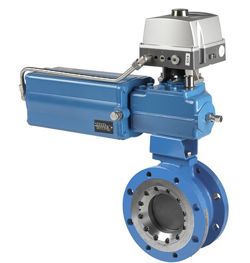
Neles™ Neldisc double flanged triple eccentric high performance disc valve
Neles™ V-port high performance segment valve
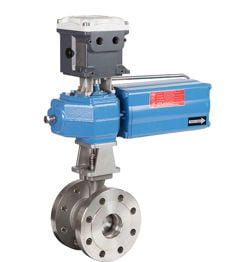
‘Then we have the rotary plug valve which is light and compact, such that smaller sizes can again be used. It therefore comes into its own in ships, skids and offshore facilities where space is at a premium.”
Markus then raises the butterfly valve, which he indicates can be made in large sizes and offers high capacity. “They are also light and offer good emissions performance,” he adds.
“And we certainly should not forget the ball valve. We see this design as a true problem solver when it comes to certain control applications. Yes, ball valves are heavy and more expensive, so not normally the first choice for control use. However, in applications where you need to work with higher pressures and high capacities they can be technically, and in the long run, also cost-wise the best options for the customer’s needs. Their emissions performance is also good thanks to the fact the stem does not rise through the packing.“
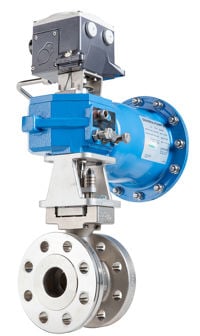
Neles™ Finetrol eccentric plug control valve
Linear heritage
Valmet Flow Control has been investing heavily to strengthen and bring back the globe valve offering to its customers. Comments Markus: “The globe valve is without doubt a respected technology and an economical selection - especially in small sizes. Having this product in our line up certainly rounds out our portfolio.”
Asked how their client base had responded to the news, Markus says: “Many clients – who know us as a rotary control valve specialist – were very pleased by the idea as they can now use us as a genuine one-stop-shop for all their control valve needs. What can be interesting is when clients approach us for a globe valve and in response we suggest that a rotary control design might actually be a better option.
Some people have, let’s say, a linear mindset. However, when we start to explain exactly why and how a rotary control valve would fill their needs then engineers are very receptive to the idea. That’s why I am delighted our portfolio now includes all types of valves so that we can offer the customer the very best choice for his application.”
Severe service takes cavitation and flashing seriously
In addition to advising on control valves for more standard use Valmet Flow Control can provide solutions for severe service applications as well. Applications where, for example, there is a need to control issues such as cavitation, flashing and noise. Comments Ismo: “Such issues are becoming more commonplace as plants are run at higher pressures and temperatures. Cavitation and flashing in particular need to be taken very seriously as otherwise you can quickly destroy a valve.”
Technologies which Valmet Flow Control can offer include their well-known Q-trim for noise reduction as well as the Tendril multihole and Omega multistage trims for noise and cavitation control. “Incidentally, our proprietary Nelprof sizing software can also predict cavitation enabling us to discuss solutions with customers at a very early stage,” says Markus.
On the topic of cavitation Ismo further adds that it is important not just to consider the valve during “steady state” operation but to bear in mind conditions during say plant start-up. “When performing control valve calculations, you should run the figures for minimum, normal and maximum flow. It makes sense to plan for the worst case. Having said that, we sometimes do advise clients that fitting cavitation trims might not be necessary. For example, if the conditions likely to cause cavitation are only expected very infrequently and then only for a short length of time. There’s no point spending money unnecessarily.”
Long-term support
Valmet Flow Control prides itself on providing a service capacity throughout the lifetime of the valve, delivering on-going support to ensure customers will realise maximum performance from their investment. Comments Ismo: “The exact level of support depends very much on the client’s preferences. Sometimes customers simply buy our valves and we don’t see them again from the moment those valves leave the factory. We respect that choice. However, it is becoming increasingly common for us to provide some degree of expertise support. For example, many customers ask us to provide assistance during start-up. This makes perfect sense given the complexity of control valve systems and the key role they play in processes.”
Regardless of the process industry or application, the company can also facilitate its customers with a range of maintenance services. Says Ismo: “given our huge installed base of control valves we have naturally amassed extensive records showing how our valves perform over extended periods. In other words, we can tell the customer what type of maintenance might be required and when. Planning maintenance activities in this way contributes to the smooth, sustainable and profitable running of the plant.”
Markus notes that, as end users further trim back their own maintenance capabilities, Valmet Flow Control staff are being increasingly called in to conduct maintenance activities on control valves. “For example, last year alone we were present during more than one hundred maintenance shut downs all over the world. This also helps us to further develop our in-depth knowledge of valve performance in the field and refine our total offering to customers.”
Digitalisation
The topic of digitalisation has long been embraced by Valmet Flow Control, who for example offer digital condition monitoring through their range of positioners. In that respect Markus is especially proud of the Neles NDX™ new generation smart positioner that was launched in 2016. “The NDX is a high capacity positioner which is simple to install, easy to commission and intuitive to use. It delivers on-line, performance and communication diagnostics and can be fitted to all valve brands and industry areas. This is yet another of our in-house developments and a product that we are all extremely pleased with.”
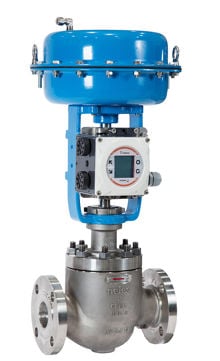
Neles™ Globe control valve with NDX smart positioner
Ismo comments that the company takes a broad view when it comes to digitalisation and is always looking to see how it can be put to good effect in various business activities. “Take data exchange for example. Now during a single project, we can be working on hundreds of control valves so there is be a tremendous flow of data between us and the EPC. If we can digitalise the data and automatize some data handling functions like mapping and conversions, we can achieve considerable time savings.
This will be beneficial to both parties, especially bearing in mind the stress caused by those inevitable last-minute changes to the specifications. That’s when the fast and correct transfer of the latest data would facilitate the accurate and prompt resizing of the valves. This is an issue we are currently discussing with selected EPCs.”
Open dialogue, it seems, is an invaluable tool for Valmet Flow Control and its clients at all levels. “If there is one piece of advice I’d like to give to potential customers it is simply this: let’s sit down and talk together. Tell us your needs and benefit from the knowledge and field data we have accumulated throughout many, many years of supplying control valves,” is how Markus puts the case for communication. Ismo concurs: “our role is to help customers in selecting the right valve for the application. No matter what your project, be it a new-build, a debottlecking activity, or even a one-off maintenance job, we are here to listen and advise so you will get the very best from your control valves.”
TEXT: David Sear
Published as cover story in Valve World magazine, November 2017.
The text has been updated in April 2022, due to the company name change to Valmet.

Subscribe to our newsletter
Subscribe now to flow control newsletter and receive the latest insights directly to your email.
SubscribeNeles Control valves
Insights into control valves


